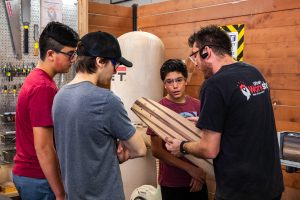From private to online, we explore school options now available for families in a post-pandemic world.
In a post-pandemic Orange County, it can be difficult to navigate the plethora of schooling options available to families. Schools have no doubt changed since 2020.
For former teachers like Tanya Martinez, a teacher of 11 years with Garden Grove Unified School District, teaching itself changed after the pandemic.
“There will be parts of a teacher’s career that feel different, especially if one continues teaching for an extended period of time,” says Martinez. “For many teachers I know, it was very challenging to return to the classroom virtually, then hybrid, then with many restrictions.”
With the onset of Zoom classes and instruction, the demand for increased access to alternative forms of education became more prevalent. Some hybrid schools, which were in operation years before the pandemic happened, started attracting more interest than ever before as alternative options for students.
Online and Hybrid
Tustin Connect is an example of a K-12 hybrid learning alternative school experience for families looking for something a little different than traditional learning environments. With K-8 curriculum aligned with both Common Core State Standards and the Tustin Unified School District, and a 9-12 grade curriculum aligned with UC A-G requirements and NCAA standards, students and parents who look at the online school on the surface and think it’s just playing on the Internet all day will be sorely mistaken.
“We have a rigorous curriculum,” says Tustin Connect Principal Erick Fineberg. “Work is done independently and students receive their lessons weeks in advance.”
While it is a public school, there is a screening process for prospective students — and with an enrollment of 100 students in grades K-8 (50 K-5, 50 6-8) and 200 for high school, it’s understandable as to why. Prospective students and their parents meet multiple times with teachers and administrators to determine if they’ll be able to handle the independent workload. Those that can are given personalized advisory support, submit assignments weekly and must attend class on their assigned days. Parental support, however, is a crucial element to student success at schools like Tustin Connect.
Andrea Peregretti, a parent with first-, third- and sixth-grade students at Tustin Connect, pulled her current third- and sixth-graders out of school during the pandemic and enrolled them at Tustin Connect.
“With Tustin Connect having been a blended program for so long prior to the pandemic, they had their stuff together where the public schools really didn’t,” says Peregretti. “We ended up staying with them ever since.”
Peregretti adds, “We love the fact that we have more time together and the flexibility. It’s the best of both worlds.”
But others may prefer online only. California Connections Academy is an example of a public school that is 100 percent online. It has “campuses” throughout California broken up into regions — the Southern California Campus consists of Los Angeles, Orange, San Diego, Riverside and San Bernardino counties. Students who meet the eligible criteria for virtual charter schools are eligible to enroll at Connections Academy. One thing of note, however, is that students who are currently expelled from their local school or district may not be eligible for enrollment. Much like hybrid schools, parents looking for a change of pace from traditional public schools or for a more flexible schedule with children involved in the arts or athletics, may find online schools appealing.
“Every family is unique in their reasoning for choosing an online learning experience. At California Connections Academy we welcome all types of students at different stages of their education journey,” says California Connections Academy’s Superintendent Richard Savage. “Some seek personalized classes and electives that fuel their passions while others prefer to learn at home because they’re being held back academically by disruptions in the classroom.”
Savage says they offer resources for different types of parents or caretakers — from stay-at-home parents to single and working parents — to support them and make online school work for their family. All parents have access to resources like video tutorials about lessons and learning tools, as well as instructional support and reference materials.
“Communication with teachers is far easier with online school,” says Adam Corcoran, a parent with two children enrolled at California Connections Academy. “I can see the grades and progress for each child just as soon as they finish an assignment. No more waiting a month for graded work in order to keep my kids accountable.”
Home Alternative
Home schools vary depending on how each parent decides to instruct their child. Orange County-based The Little Red Schoolhouse, however, is an example of an alternative learning environment serving local families.
Founder and home-schooling mother of four, Adriene Madden opened her doors to the public 10 years ago wanting to offer similar hands-on learning experiences to other families.
“We offer a multi-sensory curriculum at The Little Red Schoolhouse that is rooted in literature and writing, and offer hands-on, tangible learning experiences,” says Madden, who is also the school’s teacher. “The learning never stops.”
An approved charter school vendor, the schoolhouse features an outdoor learning environment, gardens, farm animals and interactive small-group instruction done inside of Madden’s backyard barn. With all of this, it’s understandable why there’d be an extensive vetting process for any prospective families wishing to attend the school. Serving families from all over Southern California, parental involvement, communication and flexible scheduling are obvious keys to getting a child to and from the school. Pre-K-to-second-grade small group classes meet one to two times per week and third-to-fifth-grade small group classes meet one day per week.
According to Paul Quintiliani on a video testimonial on The Little Red Schoolhouse’s website, his child immediately gravitated to the animals and the fun atmosphere at the school and speaks to it impacting his learning positively.
“It’s hard to get him to do anything,” Quintiliani says. “But from the first moment he walked through the door, it was obvious that this was a place where he was going to have fun learning.”
Faith-Based
Parents looking for an educational component that aligns with their religious views may consider a faith-based school such as Red Hill Lutheran Church and School in Tustin.
According to Lori Browne, director of admissions at Red Hill, there is a three-step process for enrollment in grades K-5. The first step is to schedule a tour of the campus. Then, enroll your child when open registration for the following school year begins in February of the current school year. The final step is to take a new student assessment to determine accurate placement for your child at the school. Families looking for small class sizes, differentiated instruction while on an accelerated path, and parents valuing the faith component can also benefit from the learning experience at Red Hill Lutheran.
Kindergarten-to-first-grade class sizes max out at 20 students per classroom, second-to-fifth-grade at 22 and middle school at 24.
For Kristine Tan-Matamoros and Chris Matamoros, parents with a sophomore currently at Ramona Convent in Alhambra, the prospects of lessened distractions and putting students in contact with professionals as guest speakers are reasons why they kept their daughter in a faith-based private school.
Public
The traditional route has always been public school. Usually assigned to a particular neighborhood and governed by an elected school board assigned to a school district, based on a particular address, public schools can offer special needs support and they ensure that California curriculum standards are being met through standardized testing. Some districts offer GATE classes for learners that are more self-driven and higher achieving. In recent years, some districts have offered dual-immersion and language academies, such as the Monroe Elementary Language Academy in Garden Grove Unified School District, as ways of competing with alternative forms of education by offering differentiated instruction by preparing students for a multilingual, multicultural world.
“[Public school] works for us because it’s been the only feasible option with a two-income household,” says Robin Foster-Tan, a parent with three boys within Garden Grove Unified School District. “We chose to keep them [sixth-grade boy, third-grade boy] at Patton because we would have to forfeit their GATE seats to go online. They would not receive the GATE-accelerated pacing online.”
Private
Private schools offer a smaller, focused approach to education. Brad Hillary, admissions director at Fairmont Schools Historic Anaheim Campus, says that students at Fairmont are excited about learning and that stems from a curriculum that builds upon the students’ interests, from arts to robotics.
“We promote life-long learners and self-confidence. Our students are incredibly confident and self-driven,” says Hillary.
For the Matamoros family, keeping their daughter in private school was, they feel, essential to their child’s learning success.
“They were able to provide her with the individual attention she needed to help her thrive. She wasn’t held back because of where the rest of the class was,” says Tan-Matamoros.
However a parent decides on making a choice for their child’s education, it’s important to remember that schools always have the best interest of the child at heart and whether it be an online academy or a public school that has been a neighborhood fixture for 70 years, the ultimate goal should be to prepare them for the world that awaits them as adults.
“My goal was always to make sure that my students left my classroom as more open-minded and accepting little humans,” says Martinez. “So, I modeled open communication, but not with the expectation of always agreeing. They knew they didn’t have to agree with each other, that they didn’t even have to like one another, but they needed to find ways to communicate in a respectful manner. I always felt this was important, but I do feel that now more than ever they need to learn this.”
By Sean Vukan








Leave a Reply